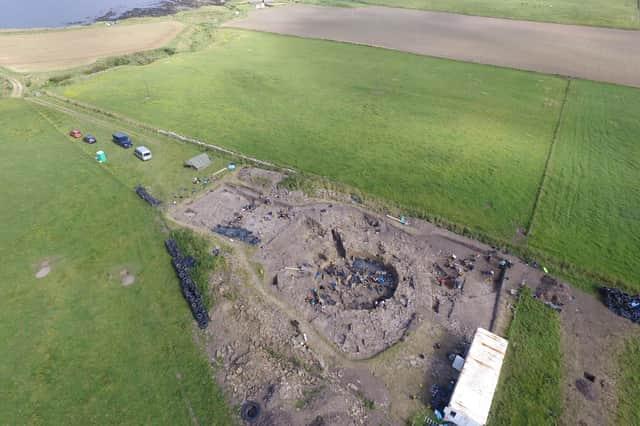Revealed: Details of massive Pictish-era feast in Orkney


Fascinating new details of a massive feasting site on Orkney, where people gathered on a clifftop in huge numbers around 1,500 years ago, have emerged.
A new radiocarbon date for a shell-filled pit at The Cairns Iron Age site in South Ronaldsay shows it was in use during the 5th or 6th century AD.
Advertisement
Hide AdAdvertisement
Hide AdThe pit appears to have been used to cook shellfish and after consumption, their shells - all 18,637 of them - were thrown back in.
Martin Carruthers, site director at The Cairns and lecturer at University of the Highlands and Islands Archaeology Institute, said: “This is an astonishing number of shells for a short-lived, single-event context. This suggests it may have been part of a special food event, a feast involving the whole community of the site or even beyond.”
The majority of the shells, which were analysed by UHI Archaeology Institute Masters student Holly Young, were limpets (84 per cent), with common periwinkles making up the rest of the shellfish menu.
The radiocarbon date shows the pit was in use at the same time as a nearby souterrain, an underground passage.
Mr Carruthers added: “One of our project research aims has been to investigate the role of souterrains and this extraordinary contemporary feasting is adding to our picture that souterrains may have been very special places involving social and ritual practices, in addition to whatever other roles they may have had in food production or storage.
“Indeed, during the construction of The Cairns souterrain another cache of shells was placed over the slab roof of the structure along with a special deposit of rotary querns.”
Archaeologists have worked at The Cairns for a number of years, but the addition of a radiocarbon date places the feast in the Pictish-era, which roughly spanned from 300AD to 800AD.
There are a number of sites across the Orkney Islands where evidence of Picts can be found, including the remains of a Pictish settlement at the Brough of Birsay which was inhabited in the late 7th Century.
Advertisement
Hide AdAdvertisement
Hide AdBy AD565, Orkney had been incorporated into the Pictish kingdom and was labelled by the collective name "Picti".
Mr Carruthers, however, cautioned against assuming it was Picts who gathered at The Cairns.
He said there was uncertainty as to whether Orkney and Shetland were fully part of the Pictish state/polity and culture.
Some believe its likely that Orkney’s ‘Picts’ were simply the descendents of the islands' Iron Age broch builders.
Earlier work at the site found that vast quantities of animal meat – including horse, red deer, cow and otter – was also consumed during an earlier feast at The Cairns, which took place a century or two before the shellfish gathering.
A large number of jewellery fragments and tools were discovered at the site several years ago.
Mr Carruthers earlier suggested that the meat feast was probably celebrating the completion of the manufacture of large batch of jewellery.
It may have been the case that pins and brooches were being handed out to members of the community at the gathering, which would likely have maintained and reinforced the structure of Iron Age society at a time when Romans could still be found further south on the mainand.